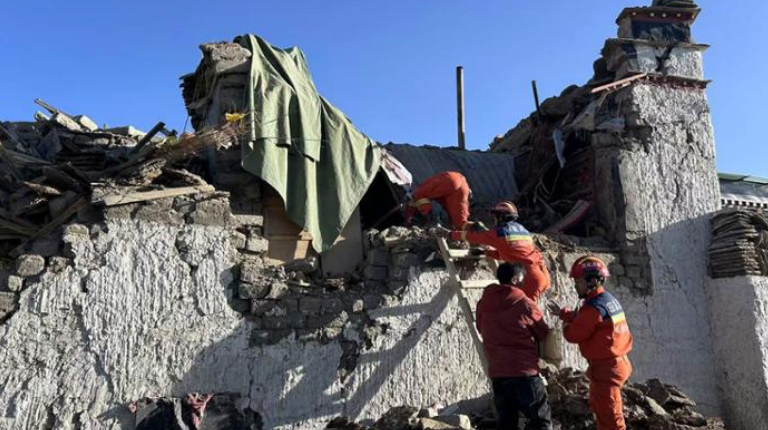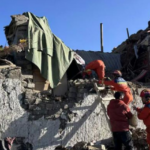<iframe src="https://bwidget.crictimes.org/" style="width:100%;min-height: 250px;" frameborder="0" scrolling="yes"></iframe>
A massive earthquake near Mount Everest claimed 53 lives, and parts of India experienced tremors.

A magnitude 7.1 earthquake that slammed Tibet close to the Nepalese border early this morning left a path of destruction and sorrow in its wake. 53 people have died as a result of the tragedy so far, while numerous others have been injured. Residents in Bihar, Assam, and West Bengal were among the regions of India that experienced the earthquakes, which sent them into a panic.
The Impact Zone and Epicenter: A massive earthquake
The earthquake’s epicenter occurred in Shigatse City, Tingri County, about 400 kilometers southwest of Lhasa, the capital of Tibet. Since Tingri is a well-known tourist destination, particularly for visitors to Mount Everest, this tragedy is highly worrisome to both locals and visitors from other countries.
According to the National Centre for Seismology (NCS), the earthquake occurred at 6:35 a.m. IST. Two aftershocks of smaller magnitude were observed shortly after the first earthquake. At 7:02 am IST, the first aftershock, with a Richter scale value of 4.7, occurred 10 kilometers below the surface. Because they are very close to the Earth’s surface, these shallow earthquakes can do more damage.
India Was Affected by Tremors: A massive earthquake
The powerful tremors were detected in multiple Indian states and went beyond the Tibetan plateau. Buildings in Bihar, Assam, and West Bengal were reported to be trembling, and many people fled their homes in terror. Although there have been no reports of significant damage or casualties in these areas, the psychological toll and brief fear underscore the earthquake’s wider impact.
In order to evaluate any possible effects within Indian territory, the National Disaster Response Force (NDRF) in India is keeping a close eye on the situation and working with local authorities.
Local and Worldwide Reaction
Chinese authorities are leading rescue and relief efforts in the impacted areas of Tibet. Teams are searching for survivors, clearing rubble, and tending to the injured. As authorities prepare for possible aftershocks, temporary shelters have been established for displaced residents.
Nepal, which borders Tibet and has experienced earthquake disasters before, is keeping a careful eye on the situation. For the region, the 2015 Nepal earthquake, which killed around 9,000 people, is still a terrible memory. The government has advised its citizens to exercise caution even though no major damage has been reported in Nepal at the moment.
The Himalayas’ Seismic Profile
The continuous collision between the Indian and Eurasian tectonic plates makes the Himalayan region one of the world’s most seismically active regions. The Himalayan mountain range was formed by this tectonic action, which also makes the area extremely earthquake-prone.
Major seismic events could occur in the area, experts have long warned. Strong disaster preparedness measures are essential, especially in susceptible regions like Tibet, Nepal, and northern India, as the recent earthquake serves as a sobering reminder.
Technology and Social Media in Earthquake Response
In the current digital era, technology is essential to disaster relief efforts. Updates regarding the earthquake, including comprehensive details about the aftershocks, were regularly posted on the National Centre for Seismology’s Twitter account. In order to keep consumers informed and ready for such crises, Indian officials created the BhooKamp app, which offers real-time earthquake notifications and safety advice.
Social networking sites are now vital resources for organizing relief operations, raising awareness, and even tracking down missing people. These platforms are essential for providing accurate and timely information to both authorities and residents.
Insights from Previous Earthquakes
- In the Himalayan region, this earthquake has rekindled conversations about earthquake preparedness. The significance of having efficient disaster management systems in place was highlighted by the 2015 Nepal earthquake. While considerable progress has been made as a result of the lessons learned from that tragedy, much more needs to be done.
- Important areas of attention consist of:
- Infrastructure: Making certain that structures are built to resist seismic activity, particularly in high-risk areas.
- Raising community awareness involves teaching locals about earthquake safety precautions like evacuation procedures and first aid methods.
- Early Warning Systems: Purchasing cutting-edge equipment to identify earthquakes and send out alerts in a timely manner.
Concern for the World and Unity
Those impacted by this tragedy have received support and condolences from the international community. India and Nepal, two nearby nations, have promised to help with relief operations if necessary. Aware of the difficulties presented by the isolated and hilly topography of the impacted areas, humanitarian organizations are also getting ready to offer assistance.
This catastrophe serves as a sobering reminder of the mutual vulnerability that the countries of the Himalayas endure. To lessen the effects of future natural disasters, cooperation is crucial on both a regional and international level.
Going Ahead
Saving lives and helping those impacted continues to be our top priority as rescue and relief efforts continue. Longer term, this earthquake emphasizes how urgently proactive steps to improve seismic hotspot resilience are needed.
The catastrophe close to Mount Everest serves as a sobering reminder of the unpredictable nature of nature and the value of being ready. For now, while the impacted communities start the challenging process of rehabilitation, the entire world looks on with solidarity and optimism.






[…] Read Also […]